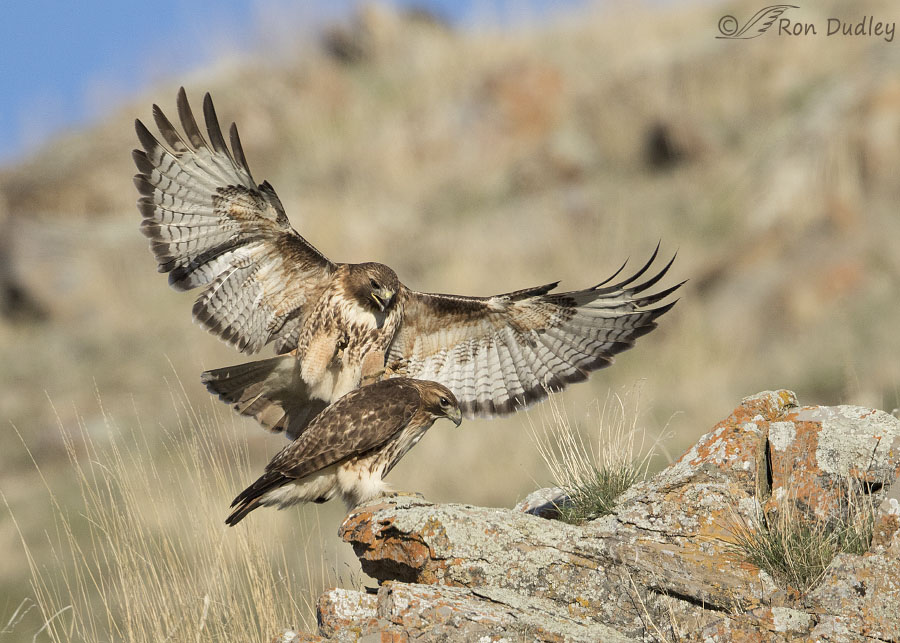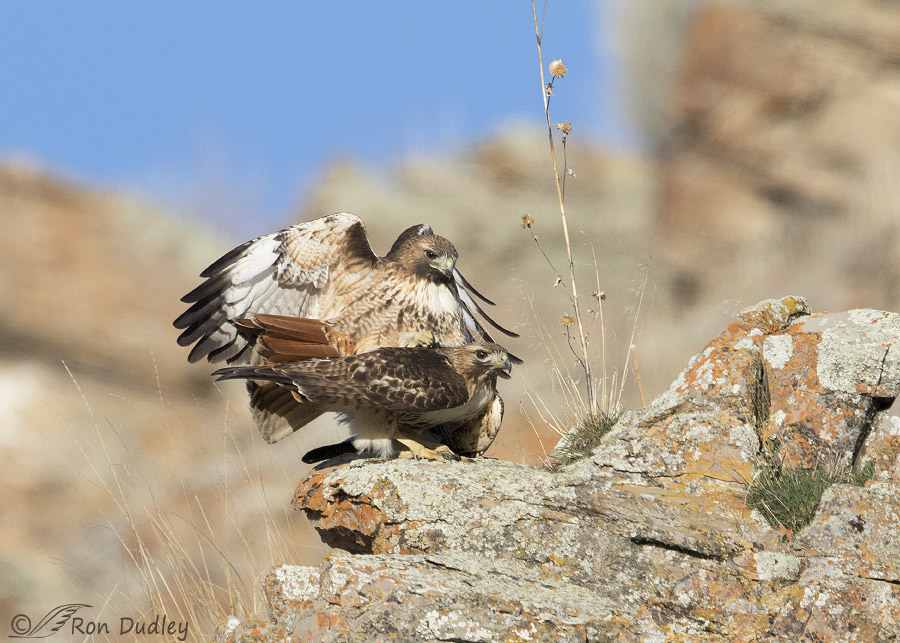Sometimes history repeats itself, even when birds are involved.
I could just show my readers a couple of sexy photos of these Red-tailed Hawks as they mated yesterday and let it go at that but I like to tell stories (especially when it involves natural history of birds) so I decided to use quite a few images to illustrate the events that led up to and followed the mating.
So sit back and enjoy, folks – it’s story time.

1/5000, f/6.3, ISO 800, Canon 7D Mark II, Canon EF 500mm f/4L IS II USM + EF 1.4 III Extender, not baited, set up or called in
Yesterday morning we finally had good light for shooting and I even found a few interesting subjects. As I drove past a known Red-tailed Hawk nesting site from previous years I could barely see a hawk on the cliff and near where an old nest was so I continued down the road. Perhaps a quarter-mile past the nest I spotted this adult Red-tail perched on some rocks some distance from me so I stopped to have a look through my lens.
It turns out that this bird was the female of a mated pair and it was her mate near the nest.

1/4000, f/6.3, ISO 800, Canon 7D Mark II, Canon EF 500mm f/4L IS II USM + EF 1.4 III Extender, not baited, set up or called in
When she eventually took off she headed in the general direction of the nest…

1/4000, f/6.3, ISO 800, Canon 7D Mark II, Canon EF 500mm f/4L IS II USM + EF 1.4 III Extender, not baited, set up or called in
but landed on some more rocks some distance short of her mate near the nest. Immediately after this photo was taken I took several shots of her looking directly ahead and toward her mate a hundred yards or so in front of her. An invitation?
I wondered if she would fly to her mate or the male would leave the nest and fly in her direction so I had to make a choice as to where I aimed my lens. This time I chose correctly because very soon after she started looking at him from her new and closer vantage point the male…

1/2000, f/6.3, ISO 800, Canon 7D Mark II, Canon EF 500mm f/4L IS II USM + EF 1.4 III Extender, not baited, set up or called in
launched from the side of the cliff, circled around behind her and…

1/5000, f/6.3, ISO 800, Canon 7D Mark II, Canon EF 500mm f/4L IS II USM + EF 1.4 III Extender, not baited, set up or called in
landed on the rocks next to and just below her. She immediately assumed a submissive, inviting posture so I anticipated what happened next.

1/4000, f/6.3, ISO 800, Canon 7D Mark II, Canon EF 500mm f/4L IS II USM + EF 1.4 III Extender, not baited, set up or called in
The male accepted her invitation and proceeded to mount her.

1/5000, f/6.3, ISO 800, Canon 7D Mark II, Canon EF 500mm f/4L IS II USM + EF 1.4 III Extender, not baited, set up or called in
Her back is a precarious perch during the frenzy of mating so even though she did her best to hold still and provide him a stable platform…

1/5000, f/6.3, ISO 800, Canon 7D Mark II, Canon EF 500mm f/4L IS II USM + EF 1.4 III Extender, not baited, set up or called in
he struggled to maintain his balance and get into an appropriate position to complete the act.

1/4000, f/6.3, ISO 800, Canon 7D Mark II, Canon EF 500mm f/4L IS II USM + EF 1.4 III Extender, not baited, set up or called in
With two cumbersome tails in the way and the ever-present danger of the male falling off the “cloacal kiss” is indeed a difficult task to accomplish and in this case it took some time. I took 58 shots during the mating process and even then I laid off my shutter button during part of the process to avoid filling up my buffer.

1/3200, f/6.3, ISO 800, Canon 7D Mark II, Canon EF 500mm f/4L IS II USM + EF 1.4 III Extender, not baited, set up or called in
To actually make contact with their cloacal openings the female had to get her tail out of the way and the male leaned far to his left just before the act was completed. It appears that the talons of his right foot are holding on for dear life so in the end I’ll bet she had some scratches up there.

1/4000, f/6.3, ISO 800, Canon 7D Mark II, Canon EF 500mm f/4L IS II USM + EF 1.4 III Extender, not baited, set up or called in
When the act was completed the male hopped off…

1/3200, f/6.3, ISO 800, Canon 7D Mark II, Canon EF 500mm f/4L IS II USM + EF 1.4 III Extender, not baited, set up or called in
and landed in the rocks in front of her for a few moments before he…

1/3200, f/6.3, ISO 800, Canon 7D Mark II, Canon EF 500mm f/4L IS II USM + EF 1.4 III Extender, not baited, set up or called in
flew off to contribute even more efforts to their nesting activities as she looked away. But “the rest of the story” will have to wait until another time. With 13 photos this post is already a very long one and I still have to add one more image.
At this point some readers may be wondering why I borrowed Yogi Berra’s famous “Yogi-ism” for my title – what does “déjà vu all over again” have to do with these mating hawks? The answer might surprise you as much as it did me when I finally connected the dots.

1/2000, f/7.1, ISO 800, Canon 7D Mark II, Canon EF 500mm f/4L IS II USM + EF 1.4 III Extender, not baited, set up or called in
This photo was taken from a slightly different vantage point one year and 12 days ago, on March 29, 2017. These are also Red-tailed Hawks, they’re also mating and they’re doing so on the same rocky outcrop as the hawks I photographed yesterday morning. In fact there’s a very good chance that they’re the same two birds! I suspect this is their favorite trysting spot and they’ve been using it for that purpose for over two years now. Maybe longer.
In the heat of the moment I’ll confess I didn’t even realize the many similarities between the two events until I left these birds yesterday and was on my way home. Hawks mate many times prior to laying eggs so maybe I’ll get lucky and be able to photograph these birds going at it again in the next week or so.
After all, as Yogi also famously said, “It ain’t over till it’s over”….
Ron


Awesome story and sequence, Ron! Thanks, too, for including your photo settings. Very instructional 🙂
So I read the second paragraph under the first photo, and I’m wondering: “How does Ron know it’s a female? He must know there is some way of telling.” And then, to paraphrase the late Paul Harvey, I read the rest of the story. Well done!
Ha, made me smile, Lyle. Yup, there’s “that”. And the female is also a little larger so when I would see them perched next to each other their size difference is apparent.
I used to listen to Paul Harvey as a kid on the farm. He was a staple for farmers back in those days…
It’s really difficult to tell a singular redtail, but when they’re side-by-side, it’s easy. HOWEVER, if you can see the tarsus (leg), if it’s the size of a AA battery, it’s a female. A male’s tarsus is about the size of a pencil. I’ve found that to be a relatively easy way to differentiate females from males. Of course to each rule must come an exception, and in redtails, it’s the tweeners–large males and small femalers. DARGH! I hope that helps 😉
How wonderful that everything came together yesterday. Pun intended.
The light, the birds, the place…
Thanks, EC.
Wonderful post Ron, Many thanks!
Went through my file of your past posts and yup there it was! Don’t ask, my wife always complains I don’t throw anything away!!
Ha, you ol’ packrat, Dick! 🙂
Very fun post! Glad you finally had some photographic luck!1
Me too, Joanne! Thanks.
Amazing behavioral series Ron! Congrats! Thanks for sharing.
Charlotte
Thank you, Charlotte.
Great series of photos! What’s known about long-term pairing among Red-Tailed Hawks? Thanks
John, Here’s what BNA Online has to say on the subject regarding Red-tailed Hawks:
“Usually maintain pair bonds until death of a partner, at least in non-migratory (resident) populations, but acquisition of a new mate can occur rapidly after the death of 1 member of the pair”
I’ve always had a love for birds. Your pictures and stories are making me love them even more. Thank you for that😜
Have a great day‼️
I’m glad you enjoyed them, Diana.
Comforting to know more Red-tails may be one the way….A wonderful series! Then let’s hope theyvall survive….
Yup, I hope there are no Red-tail nesting disasters like we had last summer, Patty.
Have I mentioned that I’m besotted with redtails? LOL! Yes, they are creatures of habit, I think in the context of if it ain’t broke… And what a delight to know that they’re making more redtails! See my happy face? 😉
Here’s to a successful nesting season! YAY!
Given my similar tendencies I’m always pleased to encounter another creature of habit, Laura!
Fantastic series. Your talents and patience is appreciated. These are sights I would never get to experience. Thank you.
Thanks, Betty.
Spectacular photos Ron. So glad you were able to hang in there through the whole mating process in order to give us these outstanding photos. Mating is in the past for us here. We are seeing fledglings popping up out of nests all over. Yesterday my friend Dave who heads up our Kestrel nesting program here had the privilege of going with the Fish and Game and Forest Service People to band the two Bald Eagle fledglings at near-by Lynx Lake. He sent me a picture they took of him holding the two young very healthy males. One was 6.5 pounds and the other 7.5. He said that the moment they were placed back in the nest one of the parents flew right in with food. I of course told him that I was very envious.
Everett Sanborn, Prescott AZ
Thanks, Everett. Yes, up here further north raptor mating and nesting activities are significantly behind yours.
I love that you picked up on the repetition. May there be healthy chicks.
Thanks, Arwen. I was surprised with myself that I didn’t immediately connect the two events. Better late than never…
Just like a guy to not stick around to cuddle. 😉 These are great shots! Can’t wait for the rest of the story.
“Just like a guy to not stick around to cuddle”
Wish I’d thought of that to use in my narrative! Thanks, Marty.
🙂 Appears they are also creatures of habit…..;) Wonderful sequence of beautiful hawks, Ron! 🙂
Thank you, Judy.
Great stuff, I’ve noticed (At least in the comparative short amount of time I’ve been photographing wildlife) that many birds do the same thing or land in the same area more than what I’d call a coincidence. Maybe there were no other “safer” perches for them to use? Or maybe they just like the view. Anyways, I hope they’re successful in their nesting attempts this year!
I’ve often noticed the same thing, Xavier. Being aware of behavioral patterns like that can certainly be a useful tool for the bird photographer. Thank you.